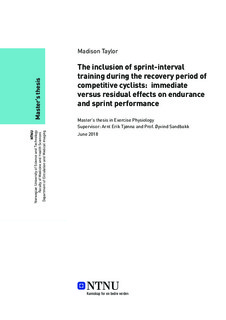| dc.description.abstract | Introduction: The annual training program of competitive cyclists is traditionally broken into the competitive-, recovery-, and preparatory period. During the recovery period, cyclists dramatically reduce their training volume and emphasis is placed on low intensity training (LIT). Previous research has shown a decline in endurance performance and loss of physiological training adaptations during this period. However, sprint-interval training (SIT) could be a potential time efficient strategy for maintaining endurance and sprint performance in trained athletes during the recovery period, with could provide benefits in the subsequent preparatory period. Aim: The aim of the current thesis was to investigate the effects of incorporating one weekly SIT session versus focusing solely on LIT during the 3-week long recovery period on endurance and sprint performance in competitive cyclists. A secondary aim was to examine the effects of these two training strategies 6-weeks into the subsequent preparatory period. Methods: 11 competitive male cyclists completed a series of performance tests directly following the competition season (pre-test), immediately after a 3-week long recovery period (post-test), and 6-weeks into the subsequent season (re-test). The SIT group (SIT, n = 5) included one SIT session per week during the 3-week long recovery period, while the LIT group (LIT, n = 6) focused only on LIT during this period. There were no differences between groups in terms of training load leading up to the recovery period or in the subsequent preparatory period. Results: Both groups were equally able to maintain maximal oxygen uptake (VO2max), peak aerobic power (Wmax), power output @ 4 mmol L- [La-], and power output during a 20 minute all out trial (PO20min) during the recovery period, and the inclusion of SIT provided no immediate advantage. However, in the absence of a high intensity training stimulus during the recovery period the LIT group experienced a significant decline to repeated sprint ability compared to the improvement seen in the SIT group following this period. 6-weeks into the subsequent preparatory period, the SIT group demonstrated a 7% improvement to PO20min from their pre-test value, which was larger than the unchanged performance in the LIT group. Conclusion: The present findings suggest that the inclusion of one weekly SIT session during the recovery period provided a residual performance advantage 6-weeks into the subsequent preparatory period, increasing the likelihood of performance improvements from the end of the competitive season to the subsequent preparatory period. | |
